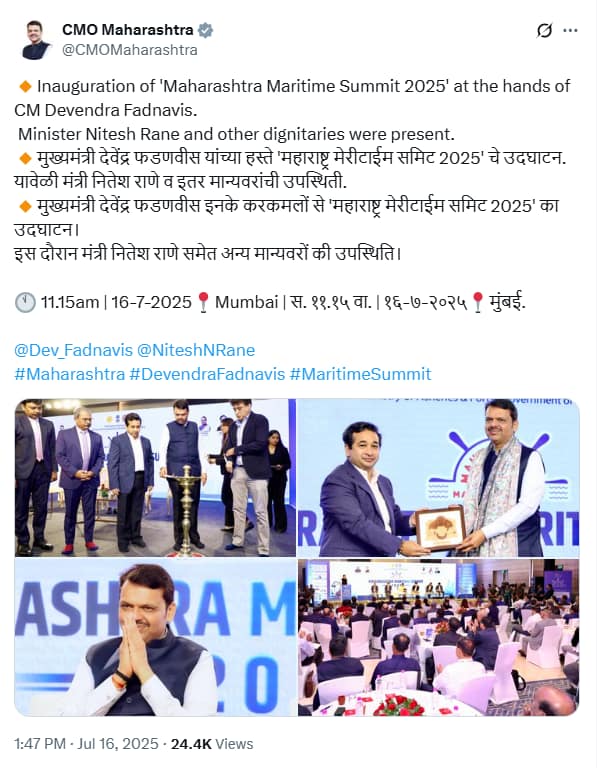The recently held Maharashtra Maritime Summit 2025, inaugurated by CM Fadnavis, was an important step forward to showcase Maharashtra’s ability and commitment to becoming a global supply chain hub and a gateway for India’s rising blue economy. Capacity building for higher self-reliance in the maritime supply chain is essential for India to keep its import/export competitive in global trading and for a stronger economy, because sea transport is the cheapest. Prime Minister Narendra Modi’s ‘Bharat Marine Vision 2030’ and ‘Bharat Amritkal Marine Vision 2047’ are targeted at increasing the country’s blue economy. Maharashtra, under the leadership of dynamic CM Devendra Fadnavis, stood up to grab emerging opportunities by contributing to realizing this vision. With two existing large ports and an upcoming deep-draft port, connected with expressway, rail, and air freight facilities, Maharashtra is already in an advantageous position to take the lead. The conference brought together government leaders, global maritime players, and private sector stakeholders in Mumbai to discuss Maharashtra’s road to the blue economy.
Transforming the state into a major maritime center
The Maharashtra Maritime Summit 2025 projected the beginning of a new era in the development of Maharashtra and India. Mumbai has always been the driver of India’s economic growth, and a lot of this success can be attributed to Mumbai Port Trust (MbPT) and Jawaharlal Nehru Port Trust (JNPT). Now with the inclusion of a deep-draft ULCV port in Vadhavan, Mumbai will be directly connected to international trade routes served by the ultra-large container vessels. Once complete, the Vadhavan port will be among the 10 largest ports in the world. This port, together with “Make in India” initiatives, will help India establish itself in the global supply chain. Although JNPT is a large port and expanding its capacity, it cannot dock ULCV containers, which is a key feature of the global supply chain. That is why the Vadhavan port development will be a game changer, as it will have 9 ULCV terminals. With the Vadhavan port handling the ultra-large cargo ships and the Mumbai port and JNPT handling smaller vessels catering to regional trades, Mumbai’s maritime power will increase manifold.
Chief Minister Devendra Fadnavis’ maritime initiatives
Chief Minister Devendra Fadnavis’ foresight and decision-making ability were manifested in the Vadhavan port development. This ambitious project was actually conceptualized in the 1990s but stuck due to environmental obstacles and lack of thrust and initiatives by the then and successive governments. But Devendra Fadnavis, realizing the mountainous potential of Vadhavan Port, resolved to clear all obstacles that hindered the project. He understood the problems associated with it, persuaded the environment ministry, local authorities, and the fishermen community with viable solutions that will not harm their income and environment, and forged a joint venture with the center to implement the project. Maharashtra has a 26 percent stake in the Vadhavan Port, which will be developed into a seamless multi-modal logistic hub with rail connectivity, Samruddhi Mahamarg, and a proposed offshore airport. 24 districts of Maharashtra will be directly connected to the Vadhavan port via the Samruddhi highway. This will create great opportunities for trading and industrialization in these districts. The maritime summit also threw a spotlight on the possibility of water transport in the Mumbai and MMR region for reducing congestion and promoting clean and efficient urban mobility.

Maharashtra has the second largest coastline in India, with 2 major ports and 48 non-major ports. Currently, only 12 non-major ports handle cargo, which underscores opportunities for further improvement of Maharashtra’s port infrastructure. Development of ports, shipyards, and maritime-related enterprises opens up employment opportunities and contributes to skills development. As trade gateways, ports can support growth of the manufacturing sector and enhance Maharashtra’s competitive advantage. Devendra Fadnavis, during his previous tenure as CM, had implemented the ‘Maharashtra Maritime Development Policy 2016 (MMDP)’ to ensure the upkeep and development of non-major ports in the state. Since five years of the last MMDP were completed, the cabinet reviewed the same and incorporated additions/alterations to introduce the updated policy called Maharashtra Maritime Development Policy 2023. In the new policy the state government included the sectors, such as shipbuilding, ship repair, and ship recycling. However, since these activities need adequate infrastructure, the Devendra Fadnavis government came up with a separate policy for the shipbuilding, ship repair, and ship recycling sector in 2025 to ensure that Maharashtra, with a strong marine transport infrastructure, leads the country’s industrial and economic progress.
Mumbai and the Konkan coast have a legacy of more than 600 years of maritime trade. The Devendra Fadnavis government has taken a big step to revive this legacy and take Maharashtra forward in areas like water transport, shipbuilding, and ship recycling. The state government is also considering options for water transport in the Mumbai-Navi Mumbai area. Chief Minister Devendra Fadnavis’ maritime initiatives, aligned with Prime Minister Narendra Modi’s ambitious plans, ‘Bharat Maritime Vision 2030’ and ‘Bharat Amritkal Maritime Vision 2047,’ will establish Maharashtra as a global supply chain hub and unlock an exponential growth prospect.

